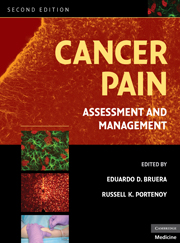Book contents
- Frontmatter
- Contents
- Contributors
- Preface
- SECTION I MECHANISMS AND EPIDEMIOLOGY
- 1 Nociception: basic principles
- 2 Pathophysiology of malignant bone pain
- SECTION II EPIDEMIOLOGY AND SYNDROMES
- SECTION III ASSESSMENT
- SECTION IV PHARMACOLOGICAL TREATMENT
- SECTION V OTHER INTERVENTIONAL STRATEGIES
- SECTION VI REHABILITATION AND PSYCHOLOGICAL INTERVENTIONS
- SECTION VII THE ROLE OF ANTINEOPLASTIC THERAPIES IN PAIN CONTROL
- SECTION VIII PAIN IN SPECIAL POPULATIONS
- SECTION IX DIFFICULT PAIN PROBLEMS
- SECTION X SYSTEMS OF CARE
- Index
- Plate section
- References
2 - Pathophysiology of malignant bone pain
from SECTION I - MECHANISMS AND EPIDEMIOLOGY
Published online by Cambridge University Press: 06 July 2010
- Frontmatter
- Contents
- Contributors
- Preface
- SECTION I MECHANISMS AND EPIDEMIOLOGY
- 1 Nociception: basic principles
- 2 Pathophysiology of malignant bone pain
- SECTION II EPIDEMIOLOGY AND SYNDROMES
- SECTION III ASSESSMENT
- SECTION IV PHARMACOLOGICAL TREATMENT
- SECTION V OTHER INTERVENTIONAL STRATEGIES
- SECTION VI REHABILITATION AND PSYCHOLOGICAL INTERVENTIONS
- SECTION VII THE ROLE OF ANTINEOPLASTIC THERAPIES IN PAIN CONTROL
- SECTION VIII PAIN IN SPECIAL POPULATIONS
- SECTION IX DIFFICULT PAIN PROBLEMS
- SECTION X SYSTEMS OF CARE
- Index
- Plate section
- References
Summary
Introduction
Currently, more than 10 million people are diagnosed with cancer every year, and by 2020, it is estimated that 20 million new cases will be diagnosed each year. In 2005, cancer caused 7.6 million deaths worldwide. In the United States, cancer is a major health problem, being the second leading cause of death. Currently, 25% of U.S. deaths are cancer related.
Cancer-associated pain may be present at any time during the course of the disease, but the frequency and intensity of cancer pain tend to increase with advancing stages of cancer. In patients with advanced cancer, 62%–86% experience significant pain, which is described as moderate to severe in approximately 40%–50% and as very severe in 25%–30%. Bone cancer pain is the most common pain in patients with advanced cancer; two thirds of patients with metastatic bone disease experience severe pain. Most common tumors, including those of the breast, prostate, thyroid, kidney, and lung, have a remarkable affinity to metastasize to bone.
Currently, the factors that drive bone cancer pain are poorly understood; however, several recently introduced models of bone cancer pain not only are providing insight into the mechanisms that drive bone cancer pain, but are guiding the development of novel mechanism-based therapies to treat the pain and skeletal remodeling that accompany metastatic bone cancer. As analgesics can also influence disease progression, findings from these studies may lead to therapies that have the potential to improve the quality of life and survival of patients with skeletal malignancies.
- Type
- Chapter
- Information
- Cancer PainAssessment and Management, pp. 23 - 34Publisher: Cambridge University PressPrint publication year: 2009



